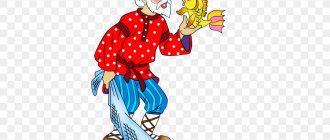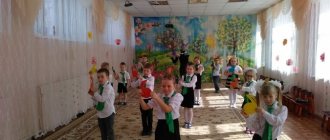Progress of the game:
The teacher addresses the children on behalf of Masha (doll)
.
- Masha asks me for a basin, a bucket of water and soap (submits the named objects )
.
- What do you think she will do? (Wash.)
Right.
- And now Masha asks to give her a saucepan, milk, sugar, salt and millet. What is Masha going to do? (The doll wants to cook porridge.)
What is the name of the porridge?
(Millet.)
Other work activities that require appropriate items in a playful form . Children are shown these objects (an iron, a stack of doll's laundry - for ironing; a bucket and watering can - for watering the beds, etc.).
Game: “Who needs this?”
Goal: to consolidate children’s understanding of objects and their use in labor processes . Introduction to professions.
Progress of the game:
The teacher tells the children: “Faith has finally recovered. We can all put things in order together. Who will take the vacuum cleaner? Take it, Galya. Who's the rag? Take it, Valya. Misha, bring us some water. Let's get started, I guess. Our faith is so neat. She loves the room to be clean and beautiful. Vera sweeps, Valya washes the floor, Galya wipes the dust. Misha, help me move the chairs. You guys do it really well. The floor is shiny, there is no dust. It comes together quickly: one or two and it’s done! Look around - cleanliness! We have a good hostess Vera. And you guys are great – you tried. Now rest, workers."
Game: "Let's go to the hospital"
.
Goal: to consolidate the idea of the medical profession ; developing children’s ability to take on the role of a doctor, perform appropriate game actions, name and use medical instruments in the game; formation of an attentive attitude towards the sick.
Material: dolls, children's doctor sets.
Progress of the game:
- Guys, listen, it seems like someone in the group is crying . Look, it was the doll Katya who was playing and injured her hand. Need to do something.
- We need to call the doctor.
- That's right, now I'll put on a white robe. I am a doctor and I will treat Katya. Here I will have a hospital, I will prepare a bandage and medicine. Let me look at your wound. Now I will anoint the wound with brilliant green and then bandage it. It won't hurt at all. Well, now, Katya, you can go home and don’t play with sharp objects . And I will see other patients.
Child - role of mother (father, doll)
.
— Hello, what hurts your daughter?
- She has a high temperature.
— Put on a thermometer and measure the temperature. Yes, the temperature is high. Let's look at the neck, open your mouth. The neck is red. Now I’ll take a phonendoscope and listen to your daughter. Your daughter has a sore throat. I will prescribe you pills, you will give one in the morning and evening, and be sure to drink hot tea with lemon.
- Goodbye.
- Next.
The child plays the role of the patient.
- Hello, patient, what hurts you?
- I have a headache.
- Take a pill and you will feel better. Go home and lie down to rest.
- Goodbye.
- Oh, the phone is ringing, I need to take the call. Hello, the doctor is listening, what happened to you? The ambulance is coming now.
“I’m leaving to see a patient; another doctor will see patients.” Lena, let's be a doctor.
The game continues with the participation of children.
Game: “We wash our combs”
.
Goal: to develop in children the skill of using and caring for their own comb. Preparing for the game. Cover the tables with oilcloth, put bowls of water for each child, soap in soap dishes, individual napkins for wiping combs, prepare a white starched robe for the bear.
Progress of the game
The teacher shows the children various objects , asks them to name them and tell them when they are used and for what purpose? For example, this is a ladle; the cook needs it to stir porridge, pour soup and compote, etc.
Game: “Choose a job”
.
Goal: the formation of elementary ideas about the professions of people whose work was not in the sphere of their observations. Arousing interest in the work of people of any profession.
Progress of the game:
The teacher and the children stand up in a round dance and invite them to walk in a circle , saying:
Let's grow up together
We'll become astronauts
And choose a job.
And we'll launch missiles.
(Children imitate the sound of an engine and the flight of a rocket, acting as shown by the teacher).
We will become captains, (Children show how captains look through binoculars.)
We will lead the ships.
Let's become helicopter pilots (Children run and make circular movements overhead.)
We'll fly the helicopters.
Game: “Why (for what, why)
do you need to do this?
Goal: developing in children an idea of the need for work , expanding knowledge about labor processes .
MAGAZINE Preschooler.RF
Familiarizing younger preschoolers with the work of adults.The peculiarity of introducing younger preschoolers to the work activities of adults is based on the inextricable unity with children’s knowledge of the man-made world. The things and toys that surround babies are of particular importance in the development of young children. Younger preschoolers actively enter the man-made world and begin to get acquainted with a large number of objects in everyday life, play and other types of children's activities. Children of this age actively experiment with both objects and materials, discovering, for example, that paper gets wet in water, a rubber ball is elastic, and jumps high if it is hit hard on the floor. Young children are attracted by the brightness and colorfulness of the objective world, which allows the teacher, based on the emotional and sensory experience of children, to help develop a value-based attitude towards the objective world.
However, most children do not see the focus of their work on results. All components of work activity are merged for them and are not perceived separately. That is why children cannot even talk about the labor processes that are carried out before their eyes every day. Teachers of younger groups introduce them to specific work processes that are performed by people working in kindergarten. At the first stages, supervision of the activities of the assistant teacher is organized: the nanny washes the dishes, sets the table, distributes food, washes the floor, wipes the dust. In the course of observing specific processes of household labor of adults, the teacher reveals to children the purpose and motives of their activity, focusing attention on each component of work, explaining their necessity.
The first component of work is goal setting and motivation of the work process. In order for children to understand the need for work and to understand the motives of adults’ activities, the teacher constructs a variety of everyday educational situations that are a natural part of the pedagogical process of the kindergarten.
For example, the tables are not set - you cannot dine, a dirty cup cannot be drunk from it. The junior teacher will take care of this. Thus, the motive of work and its significance are revealed to children through awareness of their own needs. Children's attention is directed to obtaining the result of their work.
The second component of labor - the selection of objects of labor is carried out in front of the children: the teacher offers to help the junior teacher collect dirty dishes from the tables, remove towels from the hanger, etc. This makes it possible to make our children in the labor process, assistants to adults.
The third component of labor is labor equipment. Carrying out the labor process, an adult selects the equipment necessary for its implementation, shows it to the children, names it, and the teacher provides choral pronunciation so that the names are better remembered by the children. At the same time, he pays attention to the organization of the labor process, how the adult prepared for work, why he put on an apron, why he rolled up his sleeves, etc.
The fourth component of labor is the composition and order in which adults perform labor actions. It is important that kids get a general idea of the sequence of actions, their chain. In the younger group, only the most significant of them are highlighted, and the labor process is simplified. Every significant work action is shown, explained and motivated in a form accessible to children.
For example; The nanny shows how she washes the cup: she carefully rubs it from the inside, then from the outside, the bottom, at the handle. She rubs until the cup is clean. The dirt has been wiped off, but you can’t drink from the cup, what should you do?” - the teacher asks a question. Observing the actions of the junior teacher, children answer the question posed.
The main methods of labor education are: observation of fragments of specific types of work, observation of household work, experimentation, examination of objects and pictures, didactic games (Shop, Wonderful Bag)
etc., reading poems and nursery rhymes, game situations
(Let's dress the doll for a walk)
, role-playing games.
| Next > |
Lesson notes for junior group 2 “What professions are there?”
Lesson notes for junior group 2 “What professions are there?”
Goal: To introduce children to various professions.
Tasks:
Educational:
1. Cultivate friendly relationships;
2. Cultivate interest in various types of professions.
Educational:
1. Arouse respect and the desire to imitate adults, work constantly and conscientiously.
2. Encourage children to talk about the work activities of professions familiar to them (doctor, hairdresser, builder, cook)
Educational:
1. Develop speech, auditory perception, communication skills;
2. Develop the ability to answer in complete, common sentences, observation, intelligence, and attention.
Preliminary work:
Conversations about professions, looking at illustrations on the topic, looking at tools of different professions, reading fiction.
Materials and equipment: pictures “Professions”, baskets with vegetables and fruits, first aid kit, bandage, thermometer, syringe, comb, scissors, saucepan, ladle, hammer, screwdriver, steering wheel, keys.
Progress:
I. Introductory part
1. Organizational moment ( bell, tambourine
)
There's a knock on the door. The postman sent a letter from Masha.
Educator:
Guys, postman Pechkin sent a letter, who is it from.
( from Masha)
Educator:
What is Masha writing to us?
Hello guys, I was cleaning out the table at Mishka’s house and found interesting pictures in one of the drawers, they depict people in different clothes, I don’t understand who they are, help me figure it out.
Educator:
Guys, let's help Masha find out who is shown here in the pictures?
Educator:
(
looks at the pictures
). Wow, people of different professions are drawn here. Guys, what professions do you know? (cook, driver, hairdresser, etc.)
Educator:
Well done, now let's see what professions Masha has in the pictures.
II. Main part
1. Conversation based on illustrations. (The teacher puts out the first card)
Educator:
Children, look at the picture and tell me, what profession is the person depicted?
(cook)
Well done, now Vasilisa will tell us a poem about the cook.
Vasilisa:
The cook will prepare cutlets for us,
The cake will also bake meatloaves.
It's like a magician works in the kitchen,
Everyone will have a great appetite.
Educator: -
What does the cook do?
(cooking)
- What’s cooking? (Cooks soup, compote; fries cutlets (fish or meat, scrambled eggs; bakes casseroles; makes salads; bakes pies)
— What does he have in the kitchen? (pots, knives, stove).
— Do we have a cook in the d/s?
Educator:
Let's play cooks.
( Kirill, Polina
)
Game "What's for what?" The teacher places two pots and a basket of vegetables and fruits (dummies) in front of the picture. It turns out 2 children
.
Educator:
Here are two pans.
In one we will select products for compote, and in the other we will select products for soup .
Educator:
Well done boys. They did an excellent job.
The teacher displays a picture.
Educator:
Who is shown in the picture?
(Hairdresser)
Well done, now Eva will tell us a poem about a hairdresser.
Eve:
Who's the hairdresser today? Let me be there.
I'll do your hair, for example, like mine.
Sit in front of the mirror, I'll tie the cape
And, of course, first of all, I’ll comb my hair carefully.
Educator:
Who did Eva tell the poem about?
(About the hairdresser
)
— What does a hairdresser do? ( Cuts hair, dyes hair, does beautiful hairstyles).
And what tools does a hairdresser need to cut hair and do hairstyles?
( Scissors, comb, hair dryer)
I see you are already tired. It's time for us to get some rest. Let's go for a ride in the car.
Physical school
“We’re going, we’re driving a car, (driving movements)
We press the pedal. (legs bent, knees extended)
Turn the gas on and off (turn the lever toward you, away from you)
We look intently into the distance. (palm to forehead)
Wipers count the drops
Left, right. Purity! (waving palms)
The wind will ruffle your hair. (ruffle hair with fingers)
We are drivers anywhere!” (right thumb up)
Educator:
Well done! We made good drivers.
The teacher displays a picture.
Educator:
Guys, who is shown in this picture?
(doctor)
Well done, now Nastya will tell us a poem about a doctor.
Nastya:
If your ear hurts,
If your throat becomes dry.
Don't worry and don't cry -
After all, the doctor will help you.
Educator:
Where does the doctor work?
( in the hospital)
-What is he doing? (Treats patients, measures temperature, gives an injection, listens to the heart, prescribes medicine)
Game “Doctor’s Suitcase” There are objects on the table (pills, apple, etc.)
Educator:
Children, you and I need to help pack a suitcase for the doctor, what will we take with us, and what will be unnecessary?
(Gleb, Varya)
Educator:
Well done boys. They did an excellent job.
The teacher displays a picture
Educator: Well done, guys! Next picture. Who is depicted on it? (Builder)
Well done, now Misha will tell us a poem about a builder
Misha:
He puts the bricks in a row,
He is building a kindergarten for the children.
Not a miner or a driver,
A builder will build a house for us.
Educator
: Who did Misha tell the poem about?
(About the builder)
- What does the builder do? (Builds a house, school, kindergarten, garage, fence, gate)
Educator: Is a builder a necessary profession? Well done boys!
Game “Who needs what” (Prepare supplies in a bag for each profession . Children take out from the bag items that are necessary for a particular activity. For the subject, children must name the profession in which the item is used. (saucepan, ladle, scissors, hairdryer , hammer, screwdriver, thermometer, syringe, steering wheel, keys.)
Educator
: Guys, I have a magic bag here, it contains different items, you need to determine what profession the person needs this item.
III. Final part. Reflection.
Educator:
Guys, you all did well today, and most importantly, we helped Masha find out who was drawn in the pictures that she found in Mishka’s desk. Let's remember what professions we met: doctor, driver, cook, builder, hairdresser. All professions are important and needed. Thanks to all.






